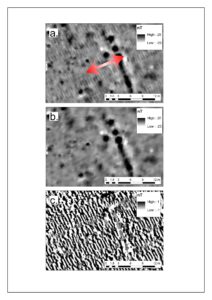
(Archaeological Prospection, 2017)
Removal of sensor tilt noise in fluxgate gradiometer survey data by applying one dimensional wavelet filtering
Archaeological prospection with magnetometer instruments is performed in a wide range of field configurations, ranging from single probe setups to mobile arrays that allow combining multiple sensors. The latter type, whereby instruments are mounted onto a cart system, are particularly prone to motion-induced noise. Sensor tilt, for example, causes in-line noise that can obscure magnetic variations present. To remediate these effects, image processing techniques are the most frequently applied. However, while efficient in producing more levelled data plots, these procedures are often associated with a smoothing penalty whereby low-intensity or small scale anomalies are masked. We propose a one-dimensional signal processing approach, based on discrete wavelet analysis. By selecting wavelets that correspond to the motion-induced noise patterns, such effects can be targeted more precisely, reducing the risk of feature masking or artefact creation. Evaluation of the proposed procedure on three fluxgate gradiometer datasets collected with a hand-propelled push-cart system, proved it a valid and more dedicated method to reduce the impact of motion induced noise in magnetometry data collected with cart mounted array setups.
Reference:
Note, N., De Smedt, P., Saey, T., Gheyle, W., Stichelbaut, B., Van den Berghe, H., Bourgeois, J., Van Eetvelde, V., & Van Meirvenne, M. (2017). Removal of sensor tilt noise in fluxgate gradiometer survey data by applying one dimensional wavelet filtering. Archaeological Prospection, 24, 4: 353–360